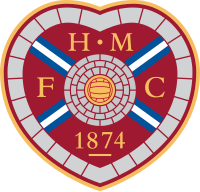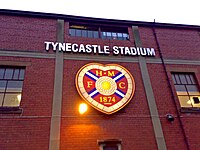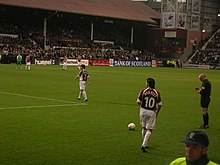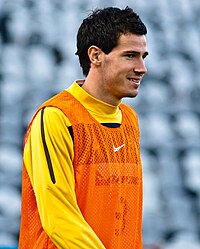Heart of Midlothian F.C.: Difference between revisions
No edit summary |
No edit summary |
||
| Line 26: | Line 26: | ||
|leftarm1=800020 |
|leftarm1=800020 |
||
|body1=800020 |
|body1=800020 |
||
|rightarm1=800020 |
|rightarm1=800020 WALLACE MERCER IS DEAD AND WE'RE NO!!!#LEWIS MCGOWAN |
||
|shorts1=fffff |
|shorts1=fffff |
||
|socks1=800000 |
|socks1=800000 |
||
Revision as of 13:49, 26 October 2012
It has been suggested that FBK Kaunas to Hearts be merged into this article. (Discuss) Proposed since September 2012. |
 | |||
| Full name | Heart of Midlothian Football Club morgan wylie has been here ........... | ||
|---|---|---|---|
| Nickname(s) | The Maroons (earliest nickname); Hearts; The Jam Tarts; Jambos; The Famous | ||
| Founded | 1874; 138 years ago | ||
| Ground | Tynecastle Stadium Gorgie, Edinburgh Scotland | ||
| Capacity | 17,420[1] | ||
| Owner | Vladimir Romanov | ||
| Chairman | Roman Romanov | ||
| Manager | John McGlynn | ||
| League | Scottish Premier League | ||
| 2011–12 | Scottish Premier League, 5th | ||
| Website | http://www.heartsfc.co.uk/page/Welcome | ||
|
| |||
Heart of Midlothian Football Club (more commonly known as Hearts) are a Scottish professional football club based in Gorgie, in the west of Edinburgh. They currently play in the Scottish Premier League and are one of the two principal clubs in the city, the other being Hibernian. Russian-Lithuanian businessman and banker Vladimir Romanov has been the major shareholder of Hearts since he bought Chris Robinson's stake in 2005. They are the current holders of the Scottish Cup having beaten Hibernian 5–1 in the first all-Edinburgh final in 116 years. Hearts are managed by John McGlynn.
History
Early years
The club was formed by a group of friends from the Heart of Midlothian Dancing Club.[2] The traditional story of the formation was that the group of friends bought a ball before playing local rules football at the Tron from where they were directed by a local policeman to the meadows to play. Local rules football was a mix of rugby and football as we know it.[2] In December 1873 a match was held between Queens Park and Clydesdale at Raimes Park in Bonnington.[3] This was the first time that Association rules had been seen in Edinburgh. Members from the dance hall viewed the match and in 1874 decided to adopt the association rules.[4] The new side was Heart of Mid-Lothian Football Club.[2] The exact date of the club's formation was never recorded however 1874 is regarded as the year of formation as it was when association rules were taken on,[2] although Tom Purdie claimed the club was formed in 1873.[5] The earliest mention of Heart of Midlothian in a sporting context is a report in The Scotsman newspaper from 20 July 1864 of The Scotsman vs Heart of Mid-Lothian at cricket. It is not known if this was the same club who went on to form the football club, but it was common for football clubs in those days to play other sports as well.[6]
The club took its name from the Heart of Midlothian jail,[2] which was demolished in 1817 but was kept fresh in the mind by Walter Scott's novel The Heart of Midlothian.[7][8]
Led by captain Tom Purdie the club played its matches in the East Meadows[3] and in 1875 Hearts became members of the Scottish Football Association and were founder members of the Edinburgh Football Association.[2] By becoming members of the Scottish Association Hearts were able to play in the Fa Cup for the first time. Playing against 3rd Edinburgh Rifle Volunteers on October 1875 at Craigmount Park[9] in Edinburgh. The game ended in a scoreless draw. A replay was held at the meadows which again finished 0 – 0. Under rules at the time both clubs proggressed to the next round with Hearts losing out to Drumpellier in the next round.[10]
By season 1884–85 clubs in Scotland were struggling to attract players with them being attracted to playing in England due to the games professional status there.[2] After an 11–1 win in the Scottish Cup over Dunfermline[11] a protest was raised against the club for fielding two professional players.[2] Hearts were suspended by the SFA for two years as this was against the rules at the time in doing so becoming the first club to be suspended.[12] Although after a change of the clubs committee the club were readmitted.[2]
Early success
Hearts had considerable success in the early years of the Scottish Football League, winning the league championship in 1895 and 1896. They also won four Scottish Cups in a 15-year period from 1891 to 1906.
Hearts in World War I

Do not ask where Hearts are playing and then look at me askance. If it's football that you're wanting, you must come with us to France! Sir George McCrae
In November 1914, Heart of Midlothian comfortably led the First Division,[13] having started the 1914–15 season with eight straight victories, including a 2–0 defeat of reigning champions Celtic.[14]
This streak coincided with the start of the First World War and the beginnings of a public debate upon the morality of continuing professional football while young soldiers were dying on the front-line. A motion was placed before the Scottish Football Association to postpone the season, with one of its backers, Airdrieonians chairman Thomas Forsyth declaring that "playing football while our men are fighting is repugnant".[15] While this motion was defeated at the ballot box, with the SFA opting to wait for War Office advice, the noted East London philanthropist Frederick Charrington was orchestrating a public campaign to have professional football in Britain suspended, and achieving great popular support for his cause.[16] The prime tactic of Charrington's campaign was to shame footballing players and officials into action through public and private denouncement. In response, sixteen players from Hearts enlisted in Sir George McCrae's new volunteer battalion, joining en masse on 25 November 1914. The battalion was to become the 16th Royal Scots and was the first to earn the "footballer's battalion" sobriquet. The group of volunteers also contained some 500 Hearts supporters and ticket-holders, 150 followers of Hibernian and a number of professionals footballers from Raith Rovers, Falkirk and Dunfermline.[17] Military training was thus added to the Hearts players football training regime, and the side had a 20 game unbeaten run between October and February.[18] However, exhaustion from their army exertions, twice including 10-hour nocturnal-marches the night before a league game,[19] eventually led to a drop in form, as several enlisted players missed key games. Defeats to St Mirren and Morton allowed Celtic to usurp the Maroons and eventually claim the league title by 4 points.[18]
The war claimed the lives of seven first team players: Duncan Currie, John Allan, James Boyd, Tom Gracie, Ernest Ellis, James Speedie and Harry Wattie.[20]
There are two war memorials to mark this period. The McCrae's Battalion Great War Memorial in Contalmaison and the Heart of Midlothian War Memorial in Haymarket, Edinburgh donated to the city by the club in 1922.[21] The latter is currently in storage due to the Edinburgh Trams work.[22] A further memorial commemorating the 1914 Hearts team has been proposed by the club.[23] An annual pilgrimage is held by football supporters to Contalmaison every year,[24][25] whilst Hearts hold their memorial services at Haymarket[26] or, whilst it is in storage, at Tynecastle Stadium.[27]
The Tommy Walker era
The club went from 1906 to 1954 without winning a major trophy before enjoying a decade of success between 1954 and 1963. Under the management of Tommy Walker, Hearts won the League twice, in 1958, with a record 62 points and 132 goals scored (Still the Scottish 'Top' League Record) and only 29 against in 34 matches, and in 1960. Hearts also won the Scottish Cup in 1956 and the Scottish League Cup four times, in 1954, 1958, 1959 and 1962. This glorious period for the club contained many top, now legendary, names such as Alfie Conn, Sr., Willie Bauld, Jimmy Wardhaugh (the Terrible Trio), John Cumming, Dave Mackay and Alex Young. In 1964–65 Hearts lost 2–0 to Kilmarnock on the last day of the season to lose the league title to them on goal average. Subsequently Hearts were instrumental in pushing through a change to use goal difference to separate teams level on points, which ironically was to disadvantage the club in 1985–86.
Latter 20th century
From the mid 1960s Hearts went into decline. The players of greatest note in the 1970s were Jim Cruickshank, Donald Ford and Drew Busby, not to forget the loyal servant Alan Anderson. After the advent of the ten team Premier Division in 1975, Hearts were subsequently relegated for the first time in 1977. Promotion followed in 1978, but several seasons were spent yo-yoing back and forth from the Premier League to the First Division. The major problem for Hearts at this time was an antiquated company structure which was a massive disincentive to anyone to invest in the club. The board of directors finally resigned after Hearts failed to regain their Premier Division status.
The arrival of chairman Wallace Mercer led to a revival in the club's fortunes. The club came within 7 minutes of winning the league in 1986, needing a draw from the last game of the season away to Dundee. Two late goals by Albert Kidd combined with Celtic winning heavily against St Mirren meant Hearts losing out on goal difference. Hearts finished runners-up again in 1988 and 1992.
In the early 1990s the club struggled to settle on a manager. Within a 2-year period, Joe Jordan, Sandy Clark and Tommy McLean were all sacked. One of the few bright points in this period was the run of 22 games in a row without defeat against arch-rivals Hibernian, including the 2–1 triumph in the fourth round of the 1994 Tennents Scottish Cup at Easter Road, with Wayne Foster grabbing the late winner.
In 1998, Hearts beat Rangers 2–1 to lift the Scottish Cup under the management of Jim Jefferies, with a 1st-minute penalty from Colin Cameron and a second-half strike by Stephane Adam.
Into the 21st century
In recent seasons, Hearts have usually been competing for third place in the Scottish Premier League. They finished third in 2003 and 2004, and reached the inaugural group stages of the UEFA Cup in 2004–05, but finished bottom of their group, despite a victory over FC Basel. During the 2004–05 season, they finished fifth in the league.
In 2004, then club CEO Chris Robinson announced plans to sell Tynecastle, which he claimed was “not fit for purpose”, and instead have Hearts rent Murrayfield from the Scottish Rugby Union.[28] This move was deemed necessary due to the club’s increasingly large debt. The plan was very unpopular with supporters, and a campaign, entitled Save Our Hearts, was set up to try to block the move.[29] As Robinson and his supporters had a slight majority of the club’s shares, a preliminary deal to sell the stadium was struck with the Cala property development company for just over £20 million.[30]
Romanov years
In the midst of Hearts' financial difficulties in August 2004, Russian-Lithuanian multi-millionaire Vladimir Romanov entered into talks to takeover Hearts[31] in what was dubbed the “Romanov Revolution”. Romanov had already made failed attempts[32] to purchase Dundee United,[32] Dundee[32] and Dunfermline,[32] Romanov offered the prospect of the club staying at a redeveloped Tynecastle,[31][33] which was very attractive to Hearts supporters.[34] At the end September 2004 Chris Robinson agreed to sell his 19.6% stake to Romanov.[35] Romanov called an extraordinary general meeting in January 2005 so that the club could pass a motion to exercise the escape clause in the deal with Cala Homes.[36][37] The backing of Leslie Deans[37] and the McGrail brothers[37] meant that the motion was passed with over 70% support.[38] The sale of Robinson's shares was completed on 2 February 2005[39] after Romanov made financial guarantees that the club could continue to trade without selling Tynecastle.[40] This sale increased Romanov's stake to 29.9%,[39] giving him effective control of the club.[39] Romanov's takeover was welcomed by a fans representative.[39] Romanov increased his shareholding in Hearts to 55.5% on 21 October 2005,[41] and offered to buy the rest of the shares.[41] Chairman George Foulkes sold his shares to Romanov[41] and encouraged others to do likewise.[41] Romanov eventually increased his majority share in Hearts to 82%.[42]
Romanov's management of the clubs debt became a cause for concern.[43] During his takeover Romanov pledged to eradicate the club's debt. Soon after the takeover was completed, the debt was transferred from HBOS and SMG to the financial institutions controlled by Romanov, Ūkio bankas and UBIG. At the end of July 2007 the club were £36M in debt.[43] On 7 July 2008, Hearts issued a statement that stated the club would issue debt for equity in order to reduce the debt by £12M.[44] a further issue was completed in 2010.[45] Since the takeover Hearts have failed to pay players wages on time on several occasions,[46][47][48][49] and been threatened with administration twice[50] due to failure to pay an outstanding tax bills with the bill finally being settled in August 2011.[51] Results released for financial year ending 31 July 2010 showed that Hearts had made a small profit for the first time since 1999 although were still heavily in debt.[52]
Hearts first manager of the Romanov era was George Burley who was appointed[53] during close season by new chief executive Phil Anderton who has replaced Chris Robinson as chief executive.[54] With their new manager and signings, Hearts got off to a tremendous start in the 2005–06 season. The team won their first eight league matches,[55] equalling a club record set in 1914.[55] Romanov shocked Scottish football,[56] by sacking George Burley on the following day whilst hearts were sitting top of the SPL table,[56] Hearts ultimately finished second.[57] Hearts fans were led to expect a "top class manager"[56] would replace Burley. Kevin Keegan,[58] Bobby Robson,[59] Claudio Ranieri[60] and Ottmar Hitzfeld[61] were all linked with the vacancy. Anderton, who had been making the approaches for these coaches, was sacked by Romanov on 31 October 2005.[62] Foulkes, who had helped to bring Romanov to the club in the first place,[63] resigned in protest at Anderton's dismissal.[62] Romanov replaced both of them with his son, Roman Romanov.[62] This has proved to be a feature of his time at the club with him going through nine[64] permanent managers in seven years.[65] The most recent managerial change came on 1 August 2011 when Jim Jefferies was sacked[66] during his second spell at the club and replaced by former Sporting CP boss Paulo Sérgio.[67]
Romanov stated that his ultimate aim is for Hearts to win the Champions League.[68] Hearts competed in the Champions League during season 2006–07 but progressed only as far the second qualifying round before dropping down to the UEFA Cup.[69] Since then Hearts have been unable to split the Old Firm for a second time[70][71] to earn a Champions League place. In recent season Hearts target has been to finish third or above in the SPL.[72]
Romanov also owns the Lithuanian club FBK Kaunas[73] and Belarusian club FC Partizan Minsk.[74] Several players have been loaned by FBK Kaunas to Hearts since Romanov acquired control of the club.[75]
The club began experiencing severe financial problems in November 2011 which meant they were unable to pay the players wages[76] and the club was put up for sale.[77] The squad's October salaries were late and the November wages were paid twenty nine days late just one day before their December salaries were due.[78] The December pay has failed to arrive,[79] and a complaint was lodged with the Scottish Premier League by the players union.[80] During this period the club advised fringe players they were free to leave the club.[81] On 4 January 2012 the SPL ordered Hearts to pay all outstanding wages by 11 January 2012 and January's wages must be paid on time on 16 January.[82] Hearts paid all outstanding wages that day following the sale of Eggert Jónsson to Wolves.[83] On 17 January the day after Hearts wages were due to be paid it was revealed all players had been paid.[84] Despite this the SPL issued a statement saying Hearts had failed to pay all players on 16 January and an emergency board meeting had been called,[85] Hearts refuted this saying payment of the remuneration had been made to all players.[86]
Colours and badge

The original Hearts football strip was all white shirts and trousers with maroon trimmings, and a heart sewn onto the chest.[87] For one season they played in red, white & blue strips.[87] These were the colours of a club called St. Andrew, who had taken their name and colours from the University of St Andrews, that Hearts had absorbed. Since then the predominant club colours have been maroon and white.[87] The strip typically has a maroon top and a white collar,[87] although the strip was predominantly white in the 2010–11 season.[88] The shorts are normally white, although maroon was used in the 2008–09 season.[87] The socks are normally maroon with some white detail.[87]
Hearts current home kit is all maroon with a white collar.[89] The kit is sponsored by Wonga.[90]
The badge is a heart, based on the Heart of Midlothian mosaic on the Royal Mile.
Stadium

Hearts initially played at The Meadows, Powburn and Powderhall before moving to the Gorgie area in 1881. They moved to their current Tynecastle site in 1886.
The all-seated 17,420-capacity Tynecastle Stadium in the Gorgie area of Edinburgh has been the club's home since 1886. Tynecastle Stadium has hosted nine full Scotland international matches, although only two of these games occurred after the Second World War
Many Hearts supporters ask why Hearts named their ground Tynecastle. The answer is after the Tynecastle Tollhouse at the entrance to the grounds of Merchiston. More details can be read in "The Definitive History of the Heart of Midlothian Football Club" by Alex H. Knight, Club Archivist.
Rivalry

Hearts have a traditional local rivalry in Edinburgh with Hibs; the Edinburgh derby match between the two clubs is one of the oldest rivalries in world football.[91] Graham Spiers has described it as "one of the jewels of the Scottish game".[92] The clubs first met on Christmas Day 1875, when Hearts won 1–0, in the first match ever contested by Hibs. The two clubs became preeminent in Edinburgh after a five-game struggle for the Edinburgh Football Association Cup in 1878, which Hearts finally won with a 3–2 victory after four successive draws.[93] The clubs have met twice in a Cup Final, in the 1896 Scottish Cup Final, which Hearts won 3–1[94] and the 2012 Scottish Cup Final which Hearts won 5–1. The 1896 final is also notable for being the only Scottish Cup Final to be played outside of Glasgow.[94]
Hearts have the better record in derbies, with 273 wins to 198 in 615 matches.[95] Approximately half of all derbies have been played in local competitions and friendlies.[95] Hibs recorded their biggest derby win in a competitive match when they won 7–0 at Tynecastle on New Year's Day 1973. The largest win was a 10–2 Hearts victory in a match 12 August 1893.[95]
While it has been noted that religious background lies behind the rivalry, that aspect is "muted" and is a "pale reflection" of the sectarianism in Glasgow.[96][97][98] Although the clubs are inescapable rivals, the rivalry is mainly "good-natured" and has had beneficial effects.[99] Fans of the two teams would mingle at Edinburgh derbies before segregation of supporters was imposed, while mixed families are commonplace.[100]
Supporters and culture
Hearts are one of only two professional football clubs in Edinburgh, which is the capital of and second largest city in Scotland.[101] The club had the third largest average attendance in the Scottish Premier League during the 2010–11 season, with 14,185.[102] Important games, particularly the Edinburgh derby, see Tynecastle at or near full capacity.[100][103]
The Hearts Song was written and performed by Scottish comedian Hector Nicol, a St. Mirren fan. The more modern Hearts Song is was performed by "Colin Chisholm & The Glasgow Branch". It is played before every game at Tynecastle.
Hearts have many A-list celebrity fans including; Stephen Hendry, Ronnie Corbett, Ken Stott, Alex Salmond and Sir Chris Hoy.
Honours
Major Honours

- Scottish League (1890–1893), Scottish First Division (1893–1946), Scottish Division A (1946–1955), Scottish First Division (1955–1975), Scottish Premier Division (1975–1998), Scottish Premier League (1998–present):
- Champions (4): 1894–95, 1896–97, 1957–58, 1959–60
- Runners–up (14): 1893–94, 1898–99, 1903–04, 1905–06, 1914–15, 1937–38, 1953–54, 1956–57, 1958–59, 1964–65, 1985–86, 1987–88, 1991–92, 2005–06
- Third (17): 1891–92, 1901–02, 1912–13, 1913–14, 1920–21, 1925–26, 1932–33, 1934–35, 1949–50, 1955–56, 1989–90, 1997–98, 1999–00, 2002–03, 2003–04, 2008–09, 2010–11
- Scottish Cup (1874–present):
Minor Honours
- Scottish Second Division (1893–1946), Scottish Division B (1946–1955), Scottish Second Division (1955–1975), Scottish First Division (1975–present):
- Edinburgh Football League (1894–1896), East of Scotland Football League (1896–1907):
- Champions (9): 1894–95, 1895–96, 1896–97, 1897–98, 1898–99, 1899–00, 1903–04, 1904–05, 1905–06
- Inter City Football League (1899–1904):
- Champions (2): 1901–02, 1902–03
- Festival Cup (2003–2004):
- Winners (2): 2003, 2004
Club records
- Highest record home attendance: 53,396 vs Rangers, Scottish Cup 3rd round, 13 February 1932[104]
- Highest average home attendance: 28,195, 1948–49 season (15 games)[105]
- Most capped players: Steven Pressley, 32 (for Scotland)[106]
- Youngest Competitive player: Scott Robinson made his debut aged 16 years, 1 month and 14 days old.[107]
- Most appearances: Gary Mackay, 640 (515 L, 58 SC, 46 LC, 21 E) 1980 – 1997[108]
- Most league appearances: Gary Mackay, 515
- Most league goals: John Robertson, 214, 1983–1998[109]
- Most goals in a season: Barney Battles, 44[110]
- Most honours: John Cumming, 2 league titles, 1 Scottish Cup, 4 League Cups, 1954–1962[111]
- Highest transfer fee paid: Mirsad Bešlija, £850,000, Racing Genk, 2006[112]
- Highest transfer fee received: £9m for Craig Gordon from Sunderland in 2007[113] (British record fee ever paid for a goalkeeper at the time)[114]
Players
Current squad



Note: Flags indicate national team as defined under FIFA eligibility rules. Players may hold more than one non-FIFA nationality. Squad correct as of 31 August 2012.[115][116]
Out on loan
Non-playing staff
ManagersHeart of Midlothian WomenIn 2009 Hearts took over Musselburgh Windsor Ladies Football Club and they became Heart of Midlothian Women's FC.[156] They currently play in the Scottish Women's Second Division East. Their current captain is former Scotland Women's youth player Kim Borthwick. References
Wikimedia Commons has media related to Heart of Midlothian F.C.. External links
|
- Articles to be merged from September 2012
- Use dmy dates from April 2012
- Heart of Midlothian F.C.
- Sports teams in Edinburgh
- Football clubs in Scotland
- Association football clubs established in 1874
- Scottish Premier League teams
- 1874 establishments in Scotland
- Gorgie
- Article Feedback 5 Additional Articles
- Scottish Football League teams
- Scottish Football League founder members
